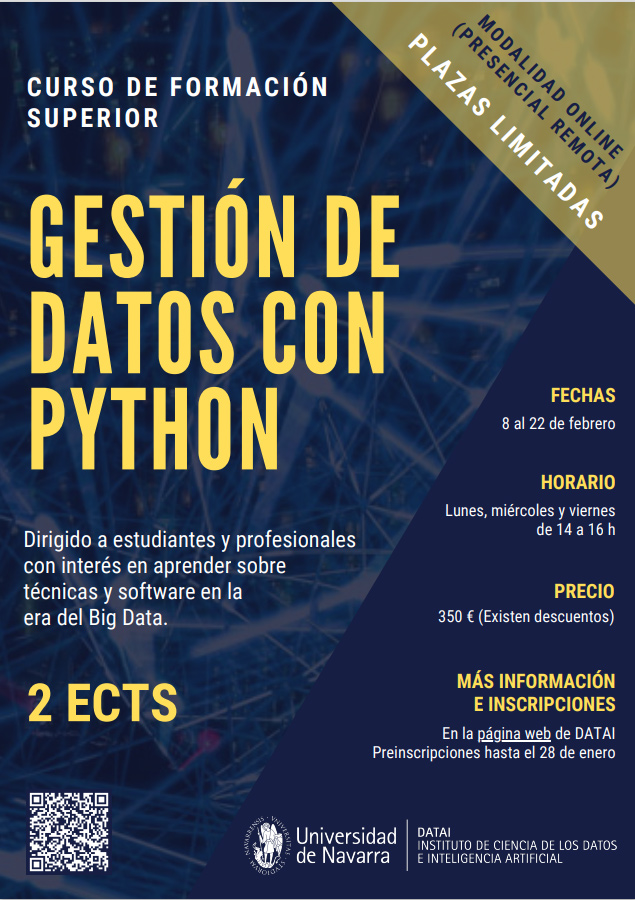Data management with Python
Python is the programming language that has grown the most in recent years. Its simple syntax close to natural language and its versatility have positioned it among the programming languages most used and required by companies.
In this course we will focus on its application to data processing, as it provides us with very interesting tools that are being applied in the area of Data Science and Big Data. We will start with the basic concepts of programming to later be able to process and visualise data.
The course is aimed at university students interested in entering the area of Data Science with basic knowledge of computers and spreadsheets.
No prior knowledge of Python or other software programming is required.
The programming software to be used is Google Colab, which does not require prior installation. It is recommended to have the Chrome browser installed on your computer.
The course is delivered synchronously online. It lasts 3 weeks, with theoretical and practical classes and tutorials lasting 2 hours.
The schedule course is as follows: Mondays, Wednesdays and Fridays from 14.00 to 16.00 h.
The programme for each session is detailed below:
Session 1 :
An introduction to Python programming and its importance for data processing in the field of Big Data and Data Science. The tool Google Colab, which will be used throughout the course, will be introduced and the basics of Python programming will be covered.
Session 2:
The second session will look at Python lists, "if" conditionals and "for" loops.
Tutorial: Friday, 12 February
In the first tutorial, doubts about the previous sessions and about the deliverable exercise will be solved. In addition, the exercises proposed during sessions 1 and 2 will be solved.
Session 3:
Python functions will be studied and we will start with an introduction to the "Pandas" library, widely used for data processing.
Session 4:
We will continue with the applications of the "Pandas" library, with special emphasis on "data frames" and reading and writing data in files.
Tutorial:
Doubts about the previous sessions and about the second deliverable exercise will be solved. In addition, the exercises proposed during sessions 3 and 4 will be solved.
Session 5:
The last session will cover data visualisation with Python.
In the sessions, exercises will be proposed so that students can work on them on their own, given that personal work is fundamental in programming. These exercises will then be solved in the tutoring sessions, where doubts about the exercises and the sessions will be resolved.
The evaluation will be carried out by means of 3 questionnaires subject test with questions on the topics covered in the sessions. The first will be on sessions 1 and 2, the second on sessions 3 and 4 and the third on session 5. You will have several days to answer each questionnaire and you will be able to ask your doubts about them in the tutorial sessions.
Each questionnaire will count for one third of the final grade of the course.
All explanation sessions will be conducted in the Zoom application and will be recorded and made available to the students.
grade: a minimum of attendance will be required to attend the sessions to be considered C.
The steps to formalise enrollment in the course are as follows:
1. Fill in and send the pre-registration form form before Thursday, 28 January 2021 at 14.00h.
2. An email will be sent on Friday 29th January informing whether or not you have been admitted to the course.
3. In the case of having been admitted, you will be provided with the link to the payment gateway in order to formalise the enrollment. It is necessary that the enrollment is formalised before Tuesday 2 February at 14.00h, otherwise your place will be sent to another candidate.
The delivery of the course will be subject to a minimum number of students.

 Download the course flyer
Download the course flyer